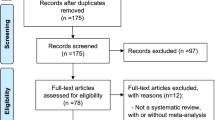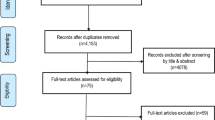Abstract
The reporting quality of Observational Studies (OSs) is an important measure of their overall quality. We aim to assess the reporting quality of OSs of Shiraz University of Medical Sciences (SUMS) in Iran in the years 2012–2015, using Strengthening the Reporting of Observational Studies checklist. Systematic online search was performed. A random sample of SUMS affiliated published articles was selected. Articles were appraised and scored by two reviewers. Variables such as the study design, publication year, journals’ impact factor etc. were retrieved and their correlation with the articles’ scores was assessed. Out of 4297 published articles during 2012–2015, 1742 (40.5%) were OSs of which we assessed 171 (~ 10%) studies. Among these, 87 (50.9%), 74 (43.3%) and 10 (5.8%) articles had a cross-sectional, case–control and cohort design, respectively. Overall score of the reporting quality was 79% ± 0.01. It was at 81% ± 0.1, 77% ± 0.01 and 83% ± 0.02 for cross-sectional, case–control and cohort studies, respectively. A significant correlation was observed between the study design and the score for the reporting quality (P = 0.015). Reporting of “flow-diagram” (5%), “sources of bias” (28%) and “study size calculation” (30%) were the most missed items. Although the overall reporting quality of OSs was found to be at an acceptable rate, there are points of concern regarding some of the most important items that deserve the attention of authors as well as reviewers and editors.


Similar content being viewed by others
References
Bastuji-Garin, S., Sbidian, E., Gaudy-Marqueste, C., Ferrat, E., Roujeau, J.-C., Richard, M.-A., et al. (2013). Impact of STROBE statement publication on quality of observational study reporting: Interrupted time series versus before-after analysis. PLoS ONE,8(8), e64733–e64733. https://doi.org/10.1371/journal.pone.0064733.
Bero, L., Chartres, N., Diong, J., Fabbri, A., Ghersi, D., Lam, J., et al. (2018). The risk of bias in observational studies of exposures (ROBINS-E) tool: Concerns arising from application to observational studies of exposures. Systematic Reviews,7(1), 242. https://doi.org/10.1186/s13643-018-0915-2.
Fung, A. E., Palanki, R., Bakri, S. J., Depperschmidt, E., & Gibson, A. (2009). Applying the CONSORT and STROBE statements to evaluate the reporting quality of neovascular age-related macular degeneration studies. Ophthalmology,116(2), 286–296. https://doi.org/10.1016/j.ophtha.2008.09.014.
Glasziou, P., Altman, D. G., Bossuyt, P., Boutron, I., Clarke, M., Julious, S., et al. (2014). Reducing waste from incomplete or unusable reports of biomedical research. Lancet,383(9913), 267–276. https://doi.org/10.1016/s0140-6736(13)62228-x.
Groenwold, R. H., Van Deursen, A. M., Hoes, A. W., & Hak, E. (2008). Poor quality of reporting confounding bias in observational intervention studies: A systematic review. Annals of Epidemiology,18(10), 746–751. https://doi.org/10.1016/j.annepidem.2008.05.007.
Hammer, G. P., du Prel, J.-B., & Blettner, M. (2009). Avoiding bias in observational studies: Part 8 in a series of articles on evaluation of scientific publications. Deutsches Arzteblatt International,106(41), 664–668. https://doi.org/10.3238/arztebl.2009.0664.
Han, S., Olonisakin, T. F., Pribis, J. P., Zupetic, J., Yoon, J. H., Holleran, K. M., et al. (2017). A checklist is associated with increased quality of reporting preclinical biomedical research: A systematic review. PLoS ONE,12(9), e0183591. https://doi.org/10.1371/journal.pone.0183591.
Hemkens, L. G., Benchimol, E. I., Langan, S. M., Briel, M., Kasenda, B., Januel, J.-M., et al. (2016). The reporting of studies using routinely collected health data was often in sufficient. Journal of Clinical Epidemiology,79, 104–111. https://doi.org/10.1016/j.jclinepi.2016.06.005.
Hoppe, D. J., Schemitsch, E. H., Morshed, S., Tornetta, P., 3rd, & Bhandari, M. (2009). Hierarchy of evidence: Where observational studies fit in and why we need them. Journal of Bone and Joint Surgery,91(Suppl 3), 2–9. https://doi.org/10.2106/jbjs.H.01571.
Irani, M., Hassanzadeh Bashtian, M., Khadivzadeh, T., Ebrahimipour, H., & Asghari Nekah, S. M. (2018). Weaknesses in the reporting of cross-sectional studies in accordance with the strobe report (the case of congenital anomaly among infants in iran): A review article. Iranian Journal of Public Health,47(12), 1796–1804.
Jeelani, A., Malik, W., Haq, I., Aleem, S., Mujtaba, M., & Syed, N. (2014). Cross-sectional studies published in indian journal of community medicine: Evaluation of adherence to strengthening the reporting of observational studies in epidemiology statement. Annals of Medical And Health Sciences Research,4(6), 875–878. https://doi.org/10.4103/2141-9248.144889.
Langan, S., Schmitt, J., Coenraads, P. J., Svensson, A., von Elm, E., & Williams, H. (2010). The reporting of observational research studies in dermatology journals: A literature-based study. Archives of Dermatology,146(5), 534–541. https://doi.org/10.1001/archdermatol.2010.87.
Leydesdorff, L., & Wagner, C. S. (2008). International collaboration in science and the formation of a core group. Journal of Informetrics,2(4), 317–325. https://doi.org/10.1016/j.joi.2008.07.003.
Low, W. Y., Ng, K. H., Kabir, M. A., Koh, A. P., & Sinnasamy, J. (2014). Trend and impact of international collaboration in clinical medicine papers published in Malaysia. Scientometrics,98(2), 1521–1533. https://doi.org/10.1007/s11192-013-1121-6.
Nagarajan, V. B., Bhide, S., Kanase, H. R., Potey, A., & Tadavi, F. (2018). Adherence of observational studiesindian journals to STROBE statement. Journal of the Association of Physicians of India,66, 39.
Poorolajal, J., Cheraghi, Z., Irani, A. D., & Rezaeian, S. (2011). Quality of Cohort studies reporting post the strengthening the reporting of observational studies in epidemiology (STROBE) statement. Epidemiology and Health,33, e2011005–e2011005. https://doi.org/10.4178/epih/e2011005.
Pouwels, K. B., Widyakusuma, N. N., Groenwold, R. H., & Hak, E. (2016). Quality of reporting of confounding remained suboptimal after the STROBE guideline. Journal of Clinical Epidemiology,69, 217–224. https://doi.org/10.1016/j.jclinepi.2015.08.009.
Ramke, J., Palagyi, A., Jordan, V., Petkovic, J., & Gilbert, C. E. (2017). Using the STROBE statement to assess reporting in blindness prevalence surveys in low and middle income countries. PLoS ONE,12(5), e0176178. https://doi.org/10.1371/journal.pone.0176178.
Rao, A., Bruck, K., Methven, S., Evans, R., Stel, V. S., Jager, K. J., et al. (2016). Quality of reporting and study design of CKD Cohort studies assessing mortality in the elderly before and after STROBE: A systematic review. PLoS ONE,11(5), e0155078. https://doi.org/10.1371/journal.pone.0155078.
Tsakiridis, I., Arvanitaki, A., & Zintzaras, E. (2019). Assessing the reporting quality of systematic reviews of observational studies in preeclampsia. Archives of Gynecology and Obstetrics,299(3), 689–694. https://doi.org/10.1007/s00404-018-5023-y.
Vandenbroucke, J. P., Von Elm, E., Altman, D. G., Gøtzsche, P. C., Mulrow, C. D., Pocock, S. J., et al. (2007). Strengthening the reporting of observational studies in epidemiology (STROBE): Explanation and elaboration. PLoS Medicine,4(10), e297.
von Elm, E., Altman, D. G., Egger, M., Pocock, S. J., Gøtzsche, P. C., Vandenbroucke, J. P., et al. (2007). The strengthening the reporting of observational studies in epidemiology (STROBE) statement: Guidelines for reporting observational studies. PLoS Medicine,4(10), e296–e296. https://doi.org/10.1371/journal.pmed.0040296.
Acknowledgements
The authors wish to thank Mr. H. Argasi at the Research Consultation Center (RCC) of Shiraz University of Medical Sciences for his invaluable assistance in editing this manuscript.
Author information
Authors and Affiliations
Corresponding author
Ethics declarations
Conflict of interest
The authors declare that they have no conflict of interest.
Rights and permissions
About this article
Cite this article
Rahmani, N., Salehi, A., Molavi Vardanjani, H. et al. Using STROBE checklist to assess the reporting quality of observational studies affiliated with Shiraz University of Medical Sciences, and its correlates: a scientometric study from Iran. Scientometrics 122, 989–1001 (2020). https://doi.org/10.1007/s11192-019-03317-3
Received:
Published:
Issue Date:
DOI: https://doi.org/10.1007/s11192-019-03317-3




